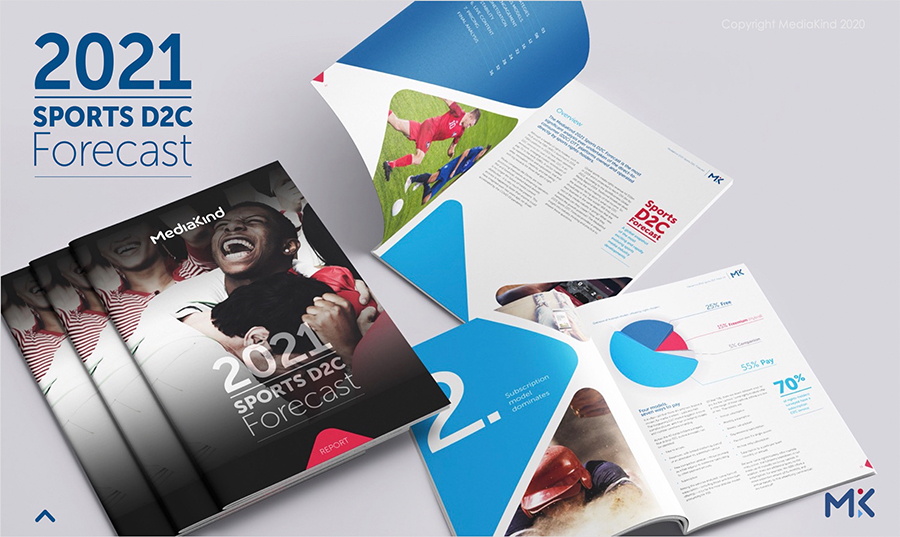At MediaKind, we have always followed three standing pillars in the digital space – robustness, scale, and quality. And it’s our deep understanding of this space that has led us to notice the shifts in the sports market towards OTT as a delivery mechanism for content, as well as engaging fans themselves.
As my colleague Lisa Aussieker mentioned in her recent blog post, we have already witnessed the shift to OTT streaming in the entertainment space through the likes of Netflix and Disney. The process of that shift from broadcast to OTT content delivery is now nearly complete, and the next battleground is in sports. That’s why MediaKind launched the 2021 Sports D2C Forecast.
Register for the webinar on December 17!
D2C models
Having analyzed 40 sports rights-holders from across the world, including the four major US sports leagues, regional confederations, national associations, leagues, and clubs, it’s clear that the sports rights-holders market is heading towards the OTT sector in a very big way. Almost the entire group of rights-holders and property owners understood the importance of going direct-to-consumer (D2C) to reach their fanbase directly. It remains front of mind in developing new services.
D2C services represent a new strategy for some of the rights-holders covered. However, our analysis shows that 70% of the rights-holders studied currently operate a subscription D2C offering of some kind. The business models vary widely – we noted that there were seven different ways to pay for content. The subscription package net has been cast widely – anything from annual and monthly to multi-game, individual, and even packages that cover small portions of a game (e.g., the fourth quarter of an NBA game).
All of these models bring with them the challenge of scale and sharp peaks in audience viewing. In handling the video peak concurrencies and the transactional-based, viewer monitoring, and monetization concurrencies is a big jump. With the prevalence of OTT technology ubiquitous in our entertainment viewing, the sports market has reached an inflection point. We expect to see a quantum leap in concurrency in sports streaming using OTT technologies.
But when we used to talk about millions of viewers watching a live, linear sports broadcast, that is and was the norm – even an expectation. Streaming performance concerns were a key factor we learned from our research on why some of the world’s largest sporting bodies have been relatively slow to launch D2C OTT services. High profile glitches during major events cause dissatisfaction among fans and damage the brand image of the sports body itself. They understand the need for robustness, quality, and cost savings in delivering a viable D2C service.
The opportunities of the D2C market
To attract and retain subscribers and to keep viewers on screen for the longest time possible, D2C OTT platforms must be able to satisfy the requirements of these increasingly demanding audiences. Having linear-broadcast-quality video is now table stakes for sports fans. Furthermore, the proliferation of devices on which streamed content can be watched requires platform operators to support multiple video formats across a complex array of device platforms.
The two-way nature of internet delivery allows for a far richer and more immersive experience for fans than is possible with linear broadcast coverage. At the same time, it will enable rights-holders to gather valuable insights into their fans’ viewing behavior and preferences. One interesting finding from the report was the 50-50 split that emerged between rights-holders who embed a range of fan engagement tools in their service and those who use their D2C platform purely as a content hub. The latter group focuses on high-quality video, ease of navigation, and building an attractive user interface.
The monetization opportunities in the space are ripe – but mostly untapped. It was indeed a surprise to me that only 8% of the rights-holders we analyzed had engaged with some form of advertising on their OTT service. For me, personalized advertising is the next frontier, given the promise it brings to bringing ARPU for ad-revenues. Another open target is betting. None of the 40 rights holders we analyzed has an integrated betting service within its D2C service. However, since the legalization of sports betting in 2018 in the US, all major sports bodies in the country are currently developing services that will enable fans to place bets around the live content they are streaming.
A period to reassess business models for sports rights-holders
As the traditional pay-TV service bundle continues to dismantle, sports rights-holders have the power and necessity to reevaluate how they move forward to preserve and grow the value of their content. For many, it is a critical juncture – particularly for those whose broadcaster rights contracts are up for renewal. They want to experiment, learn from the market, and leverage the opportunities when these rights come up for renewal to protect and expand their revenues while creating new areas that address their fans’ needs.
OTT enables these rights-holders to do things they would otherwise not have been able to do in the broadcast world – namely, find a new way to engage fans. An engaged user is usually a monetizable user. In the age of broadcast, it has been a traditionally sit-back experience. You plug in your TV, you pay your subscription for channels, and the broadcast production team decides exactly what you see in terms of the camera angles, listen to with selected commentary, and how you interpret data by presenting selected statistics. Instead, D2C puts the fan in control of the experience, enabling them to both lean back and forward.
There is another factor to consider too. How do fans in leagues of all sizes address the issue of connecting with fans in dark markets? These dark markets are not usually where most of the fanbase resides and getting broadcaster rights at the right price has always been a challenge for sports entities. Using D2C to enter these markets is an open target for most sports leagues and federations today – and offers a perfect blend of reach, engagement, and revenue.
Join us for a Webinar!
I invite you to join Lisa and I as we present a deep-dive webinar exploring this research’s findings in greater detail. The D2C market is still largely one of experimentation and opportunity, and we look forward to sharing our thoughts on where this burgeoning market is heading!
Register for the webinar on Thursday December 17 at 10am CST/4pm GMT below!



